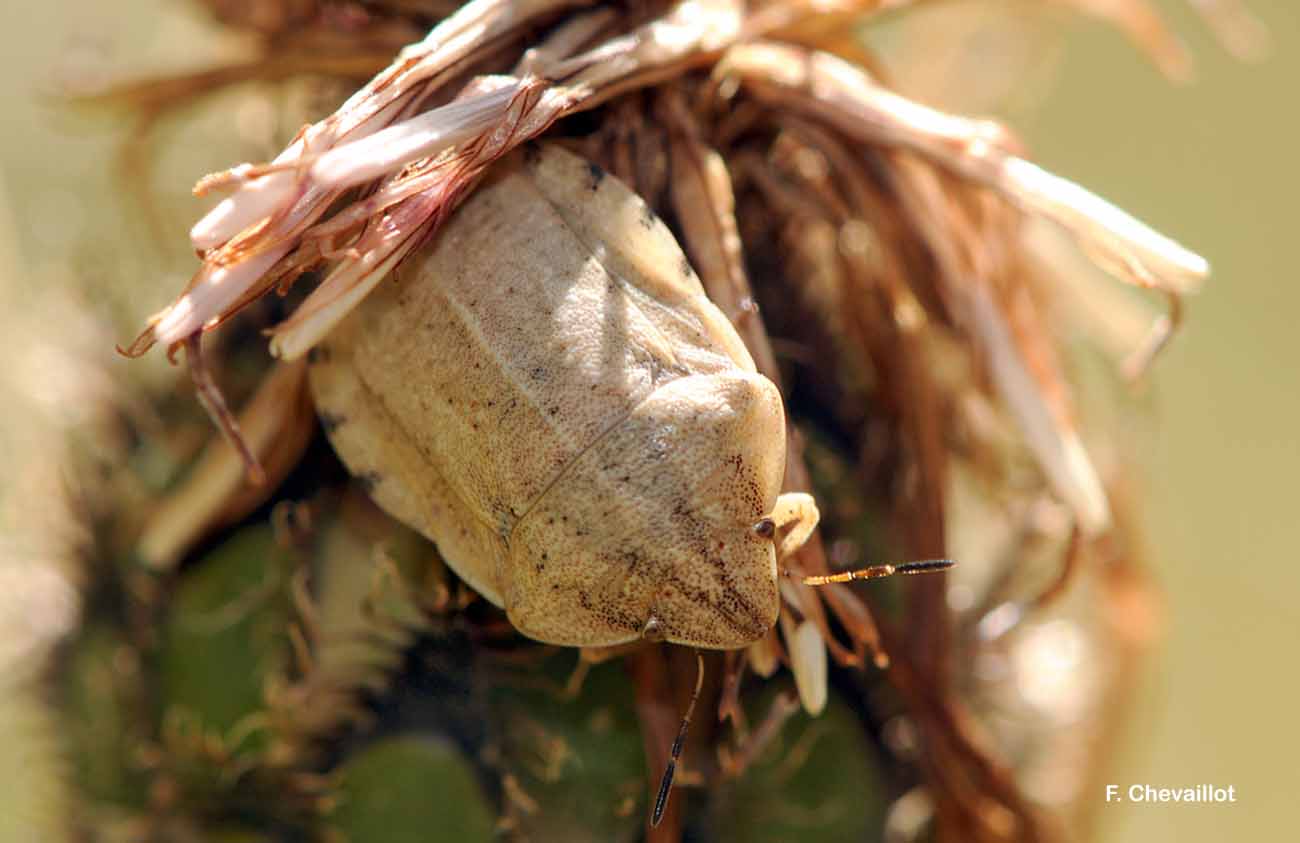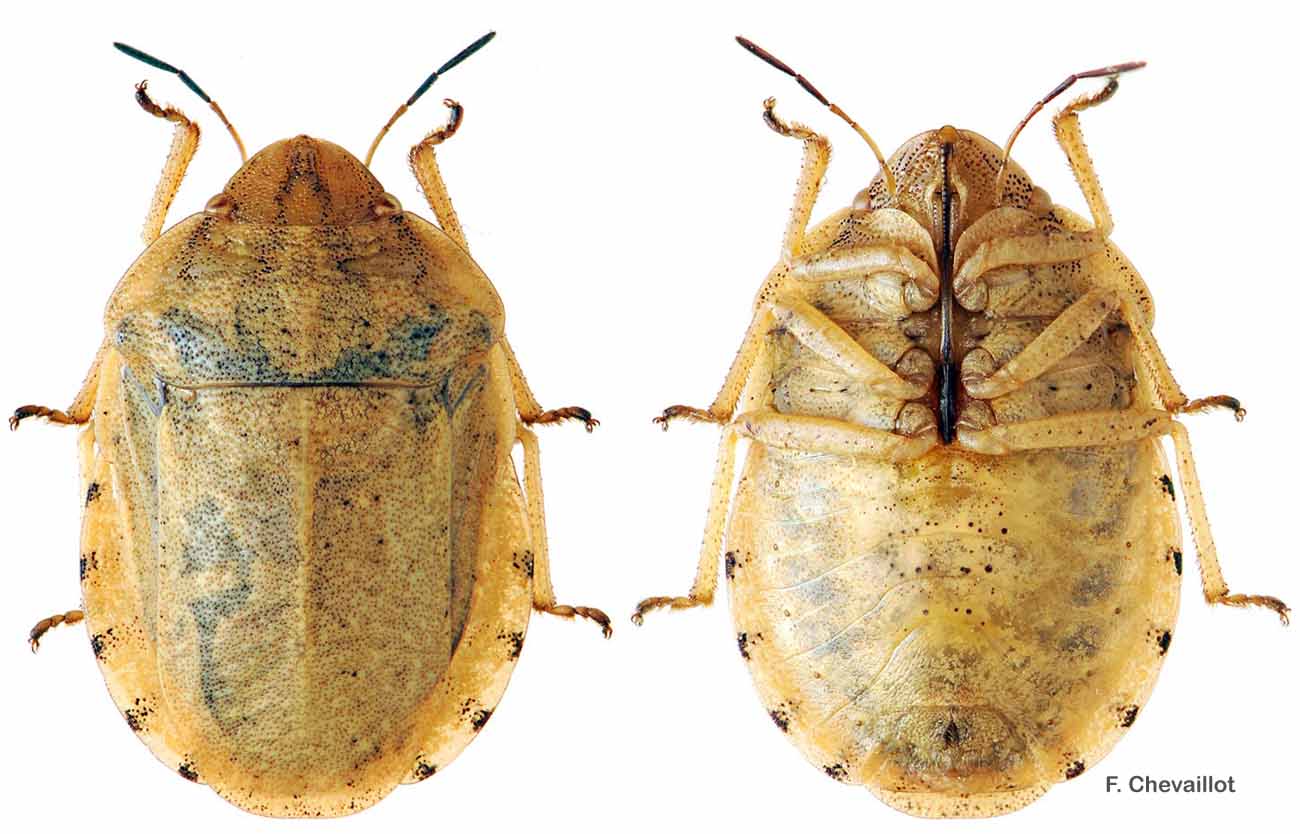
cd_nom

| Author : F. Chevaillot |
 |
To get the picture, please visit:
Fred CHEVAILLOT
Moulin de Castor
La Maynobe
12550 COUPIAC
06 51 19 18 32
09 88 28 31 26
www.insecte.org
email : fred.chevaillot@wanadoo.fr
Any reuse of one or more photographs on this site is subject to an authorization request from the author.
Link to the Code of Intellectual Property (Legifrance)

| Author : F. Chevaillot |
 |
To get the picture, please visit:
Fred CHEVAILLOT
Moulin de Castor
La Maynobe
12550 COUPIAC
06 51 19 18 32
09 88 28 31 26
www.insecte.org
email : fred.chevaillot@wanadoo.fr
Any reuse of one or more photographs on this site is subject to an authorization request from the author.
Link to the Code of Intellectual Property (Legifrance)
Taille : 8,5 – 10 mm
Diagnose :
Petite punaise ovale, rencontrée en altitude, dont le scutellum recouvre les ailes et l'abdomen en atteignant son extrémité. Sa coloration est généralement uniforme et brun foncé, mais elle est variable. Le scutellum est lisse et porte une carène médiane longitudinale plus claire que le reste du corps, et ses joues (jugas) ne se rejoignent pas devant le nez (clypéus).
Détermination : Moyennement difficile.
Espèces proches :
Elle se distingue d'Eurygaster hottentotta et Eurygaster austriaca par sa plus petite taille et parce que ces espèces ont le clypéus enclos par les joues. Elle ressemble à Eurygaster maura mais s'en distingue par les bords latéraux de son pronotum qui sont convexes, alors qu'ils sont droits chez Eurygaster maura et Eurygaster testudinaria.
Période d'observation :
Fin juin à début aout.
Biologie-éthologie :
On rencontre cette espèce sur des graminées de moyenne altitude, dont le dactyle aggloméré.
Biogéographie et écologie :
Espèce à distribution morcelée dans le sud de l'Europe que l'on rencontre à l'est jusqu'au Kazakhstan et au Kirghizstan. C'est une espèce très rare et localisée limitée à quelques sites d'altitude de 950 à 2 300 m d'altitude, mais surtout à partir de 1 600 m. On la rencontre dans les prairies sèches d'alpages, les vallées d'altitude non pâturées et les rocailles steppiques avec des touffes de graminées éparses.
Roland Lupoli (),2020
Continental
Metropolitan France
Overseas
Marine
Metropolitan France
Overseas
The map presents a summary at the 10 x 10 km grid of the observation data for the species transmitted to the SINP. These data have been subjected to validation filters.
The map presents a reference distribution layer of the species at the scale of departments and marine sectors. The presence and absence data were established by expertise within a network of partners. This reference distribution is used in the validation process of the SINP data at the INPN level.
Corresponds to a report on the basis of at least one observation proved within a period of 10 years (20 years for little-known invertebrates) preceding the year and no presumption of extinction since obtaining the last data nor doubt on reproductive and implemented nature of this population. For migratory species, the presence indicated concerns areas of reproduction.
This status is based on one or more of the following criteria:
This point covers the absence, more difficult by nature to demonstrate than presence. This status is based on one or more of the following criteria:
This status must be assigned to a department in which the presence of the species is casual.
Particular case of absence due to a proven extinction less than a half century ago (older disappearances are treated as "no probable or definite").
In the state of knowledge, we can not comment on the presence or absence in the current department. This is the default status when not comprised in one of the previous categories or whenever there is doubt.
The map shows the global distribution of the species based on GBIF data (Global Biodiversity Information Facility).
